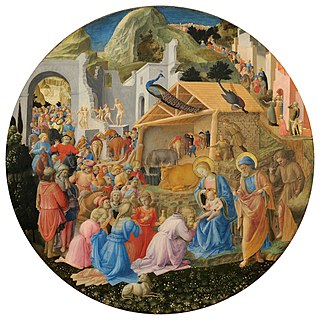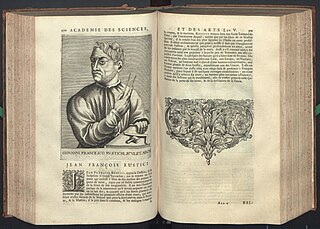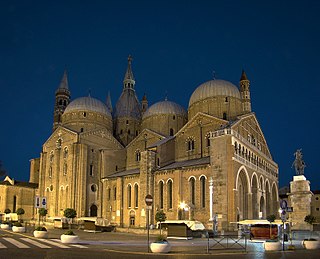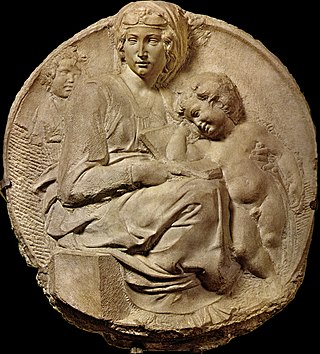
Michelangelo di Lodovico Buonarroti Simoni, known as Michelangelo, was an Italian sculptor, painter, architect, and poet of the High Renaissance. Born in the Republic of Florence, his work was inspired by models from classical antiquity and had a lasting influence on Western art. Michelangelo's creative abilities and mastery in a range of artistic arenas define him as an archetypal Renaissance man, along with his rival and elder contemporary, Leonardo da Vinci. Given the sheer volume of surviving correspondence, sketches, and reminiscences, Michelangelo is one of the best-documented artists of the 16th century. He was lauded by contemporary biographers as the most accomplished artist of his era.

Donato di Niccolò di Betto Bardi, better known as Donatello, was an Italian sculptor of the Renaissance period. Born in Florence, he studied classical sculpture and used his knowledge to develop an Early Renaissance style of sculpture. He spent time in other cities, where he worked on commissions and taught others; his periods in Rome, Padua, and Siena introduced to other parts of Italy the techniques he had developed in the course of a long and productive career. His David was the first freestanding nude male sculpture since antiquity; like much of his work it was commissioned by the Medici family.

Jacopo Bellini was one of the founders of the Renaissance style of painting in Venice and northern Italy. His sons Gentile and Giovanni Bellini, and his son-in-law Andrea Mantegna, were also famous painters.

Luca della Robbia was an Italian Renaissance sculptor from Florence. Della Robbia is noted for his colorful, tin-glazed terracotta statuary, a technique that he invented and passed on to his nephew Andrea della Robbia and great-nephews Giovanni della Robbia and Girolamo della Robbia. Although a leading sculptor in stone, after developing his technique in the early 1440s he worked primarily in terracotta. His large workshop produced both less expensive works cast from molds in multiple versions, and more expensive one-off individually modeled pieces.

Desiderio da Settignano, real name Desiderio de Bartolomeo di Francesco detto Ferro was an Italian Renaissance sculptor active in north Italy.

Antonio Gamberelli (1427–1479), nicknamed Antonio Rossellino for the colour of his hair, was an Italian Renaissance sculptor. His older brother, from whom he received his formal training, was the sculptor and architect Bernardo Rossellino.

The Madonna of the Stairs is a relief sculpture by Michelangelo in the Casa Buonarroti, Florence. It was sculpted around 1490, when Michelangelo was about fifteen. This and the Battle of the Centaurs were Michelangelo's first two sculptures. The first reference to the Madonna of the Stairs as a work by Michelangelo was in the 1568 edition of Giorgio Vasari's Lives of the Most Excellent Painters, Sculptors, and Architects.

A tondo is a Renaissance term for a circular work of art, either a painting or a sculpture. The word derives from the Italian rotondo, "round." The term is usually not used in English for small round paintings, but only those over about 60 cm in diameter, thus excluding many round portrait miniatures – for sculpture the threshold is rather lower.

Giovan Francesco Rustici, or Giovanni Francesco Rustici, (1475–1554) was an Italian Renaissance painter and sculptor. He was born into a noble family of Florence, with an independent income. Rustici profited from study of the Medici sculpture in the garden at San Marco, and according to Giorgio Vasari, Lorenzo de' Medici placed him in the studio of Verrocchio, and that after Verrocchio's departure for Venice, he placed himself with Leonardo da Vinci, who had also trained in Verocchio's workshop. He shared lodgings with Leonardo while he was working on the bronze figures for the Florence Baptistry, for which he was ill paid and resolved, according to Vasari, not to work again on a public commission. Moreover, an echo of Leonardo's inspiration is unmistakable in the much-discussed and much-reviled wax bust of "Flora" in Berlin, ascribed to a circle of Leonardo and most probably to Rustici. At this time, Pomponius Gauricus, in De sculptura (1504), named him one of the principal sculptors of Tuscany, the peer of Benedetto da Maiano, Andrea Sansovino and Michelangelo. It may have been made in France, perhaps in the circle of Rustici, who entered Francis I's service in 1528.

The Pontifical Basilica of Saint Anthony of Padua is a Catholic church and minor basilica in Padua, Veneto, Northern Italy, dedicated to St. Anthony of Padua.

The San Zeno Altarpiece is a polyptych altarpiece by the Italian Renaissance painter Andrea Mantegna created around 1456–1459. It remains in situ in the Basilica di San Zeno, the main church of the Northern Italian city of Verona. Mantegna's style mixes Greco-Roman classical themes along with Christian subjects in this altarpiece. The central panel, along with the three paintings that comprise the predella, were taken in 1797 by the French. While the main, central scene was returned by the French to Verona in 1815, the three predella paintings in Verona today are copies, since the original ones remain in France at the Louvre (Crucifixion) and in the Musée des Beaux-Arts in Tours. The paintings are made with tempera on panel; not oil as mistakenly identified in one source.
Giovanni Bastianini was an Italian sculptor who began his career as a stonecutter in the quarries at Fiesole, and was sent by Francesco Inghirami to study in Florence, first with Pio Fedi and then with Girolamo Torrini, with whom he collaborated on a statue of Donatello for the portico of the Uffizi. Bastianini's name became famous in connection with his unmasking as the first widely publicized art forger.

The Virgin and Child with Four Angels, also known as the Chellini Madonna, is a bronze roundel by the Florentine artist Donatello in the Victoria and Albert Museum, London.

The Pitti Tondo is an unfinished marble relief of the Virgin and Child by Michelangelo in round or tondo form. It was executed between 1503 and 1504 while he was residing in Florence and is now in the Museo nazionale del Bargello in Florence.

The Girdle of Thomas, Virgin's Girdle, Holy Belt, or Sacra Cintola in modern Italian, is a Christian relic in the form of a "girdle" or knotted textile cord used as a belt, that according to a medieval legend was dropped by the Virgin Mary from the sky to Saint Thomas the Apostle at or around the time of the Assumption of Mary to Heaven. The supposed original girdle is a relic belonging to Prato Cathedral in Tuscany, Italy and its veneration has been regarded as especially helpful for pregnant women. The story was frequently depicted in the art of Florence and the whole of Tuscany, and the keeping and display of the relic at Prato generated commissions for several important artists of the early Italian Renaissance. The Prato relic has outlasted several rivals in Catholic hands, and is the Catholic equivalent of the various relics held by Eastern Christianity: the Cincture of the Theotokos of the Eastern Orthodox Church and the Holy Girdle of the Syriac Orthodox Church.

The Pazzi Madonna is a rectangular "stiacciato" marble relief sculpture by Donatello, since 1886 in the sculpture collections of the Bode-Museum in Berlin. Dating to around 1420 and 1425 at the beginning of Donatello's collaboration with Michelozzo, it was most likely produced for private devotion and possibly commissioned by the Pazzi family for their home in Florence. The composition was very popular and is known in several copies.

Stiacciato (Tuscan) or schiacciato is a technique where a sculptor creates a very shallow relief sculpture with carving only millimetres deep. The rilievo stiacciato is primarily associated with Donatello (1386–1466).

The Piot Madonna is a c.1440 or c.1460 relief sculpture in roundel form by Donatello in the very unusual combination of polychrome terracotta with glass and wax inlays. It is now in the Louvre after being donated to that museum in 1890 by Eugène Piot, after whom it is named.

Madonna of the Apple is a c. 1400–1425 terracotta sculpture attributed to Donatello or Luca della Robbia, with Jacopo della Quercia also suggested in the past. It is now in the Museo Bardini, in Florence.

Nanni di Bartolo, also known as "il Rosso", was a Florentine sculptor of the Early Renaissance, a slightly younger contemporary of Donatello. His dates of birth and death are not known, but he is recorded as an active master from 1419 to 1451.



















